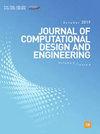基于外观的多层次信息元素特征融合注视估计
IF 6.1
2区 工程技术
Q1 COMPUTER SCIENCE, INTERDISCIPLINARY APPLICATIONS
引用次数: 0
摘要
注视估计是认知科学、人机交互和机器人技术许多应用中的一项基本任务。纯数据驱动的基于外观的凝视估计方法可能缺乏可解释性,这阻碍了它们在普遍场景中的适用性。为了提高基于外观的注视估计模型的综合性能,提出了一种多层次信息元素的特征融合方法。对原始捕获图像进行多层次特征提取和表达,建立多层次信息元素矩阵。为合理融合已建立的矩阵中的信息元素,提出了注视传导原理。根据注视传导原理,结合矩阵,提出了一种用于注视估计的多级信息元素融合模型。然后,设计了MIEF模型的几种输入模式和网络结构,并在小尺度子数据集上进行了一系列分组实验。选择优化后的MIEF模型的输入模式和网络结构,在整个数据集上进行训练和测试,验证和比较模型的性能。实验结果表明,在输入控制模块中对特征组合进行优化,在特征提取模块中对计算架构进行微调,可以提高注视估计模型的性能,使模型能够通过融合关键特征进行约简,从而提高方法的性能和可及性。与参考基线相比,基于所提出的多层次信息要素特征融合方法的优化模型在验证实验中能够实现高效训练,提高测试精度。GazeCapture数据集在手机上的平均误差为1.63厘米,这与最先进的方法达到了相当的精度。本文章由计算机程序翻译,如有差异,请以英文原文为准。
Appearance-based gaze estimation with feature fusion of multi-level information elements
Gaze estimation is a fundamental task in many applications of cognitive sciences, human-computer interaction, and robotics. The purely data-driven appearance-based gaze estimation methods may suffer from a lack of interpretability, which prevents their applicability to pervasive scenarios. In this study, a feature fusion method with multi-level information elements is proposed to improve the comprehensive performance of the appearance-based gaze estimation model. The multi-level feature extraction and expression are carried out from the originally captured images, and a multi-level information element matrix is established. A gaze conduction principle is formulated for reasonably fusing information elements from the established matrix. According to the gaze conduction principle along with the matrix, a multi-level information element fusion (MIEF) model for gaze estimation is proposed. Then, several input modes and network structures of the MIEF model are designed, and a series of grouping experiments are carried out on a small-scale sub-dataset. Furthermore, the optimized input modes and network structures of the MIEF model are selected for training and testing on the whole dataset to verify and compare model performance. Experimental results show that optimizing the feature combination in the input control module and fine-tuning the computational architecture in the feature extraction module can improve the performance of the gaze estimation model, which would enable the reduction of the model by incorporating the critical features and thus improve the performance and accessibility of the method. Compared with the reference baseline, the optimized model based on the proposed feature fusion method of multi-level information elements can achieve efficient training and improve the test accuracy in the verification experiment. The average error is 1.63 cm on phones on the GazeCapture dataset, which achieves comparable accuracy with state-of-the-art methods.
求助全文
通过发布文献求助,成功后即可免费获取论文全文。
去求助
来源期刊

Journal of Computational Design and Engineering
Computer Science-Human-Computer Interaction
CiteScore
7.70
自引率
20.40%
发文量
125
期刊介绍:
Journal of Computational Design and Engineering is an international journal that aims to provide academia and industry with a venue for rapid publication of research papers reporting innovative computational methods and applications to achieve a major breakthrough, practical improvements, and bold new research directions within a wide range of design and engineering:
• Theory and its progress in computational advancement for design and engineering
• Development of computational framework to support large scale design and engineering
• Interaction issues among human, designed artifacts, and systems
• Knowledge-intensive technologies for intelligent and sustainable systems
• Emerging technology and convergence of technology fields presented with convincing design examples
• Educational issues for academia, practitioners, and future generation
• Proposal on new research directions as well as survey and retrospectives on mature field.
 求助内容:
求助内容: 应助结果提醒方式:
应助结果提醒方式:


